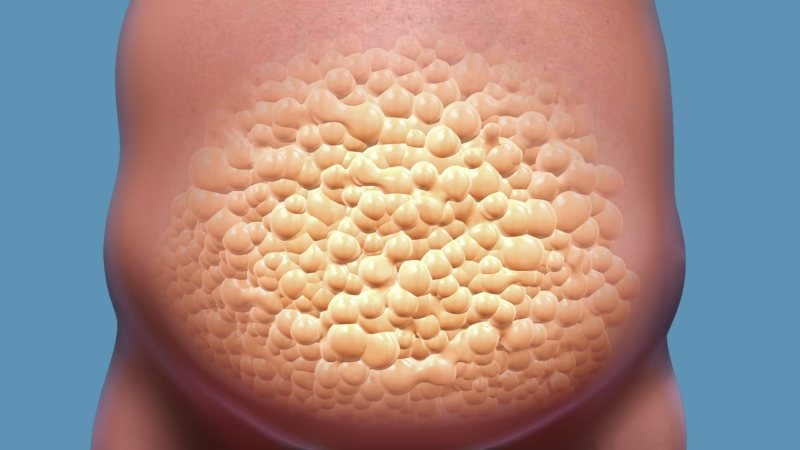Have you ever wondered why some people seem to stay fit and energetic well into their later years, while others struggle with weight gain, fatigue, and dwindling stamina?
The answer may lie not just in your lifestyle choices but in your metabolic age.
Metabolic age is more than just a number—it’s a reflection of how efficiently your body burns calories and utilizes energy. In other words, it tells you how “young” or “old” your metabolism truly is.
Imagine two people of the same chronological age: one feels vibrant and full of energy, while the other feels sluggish and struggles with stubborn weight gain. What sets them apart isn’t just their lifestyle habits—it’s the way their bodies convert fuel into energy.
Your metabolic age might be higher than your actual age if your metabolism is sluggish and inefficient, but don’t worry—recognizing the signs is the first step to taking control.
1. Unexplained Weight Gain

One of the most common signs of an elevated metabolic age is unexpected weight gain, even without significant changes in diet or physical activity.
As metabolism slows down, your body burns fewer calories at rest, leading to fat accumulation, particularly around the abdomen.
This is largely due to the natural decline in basal metabolic rate (BMR) as you age.
A study by NCBI found that aging is associated with a reduction in BMR and muscle mass. This decline contributes to weight gain and fat redistribution, especially in postmenopausal women and older adults.
How to Counteract It
2. Persistent Fatigue
View this post on Instagram
Feeling constantly tired despite adequate sleep may indicate a sluggish metabolism. Your body may not efficiently convert food into energy, leading to fatigue and lethargy.
This lack of energy is often linked to reduced mitochondrial function and oxidative stress.
A study by the National Healthcare Center highlights that reduced mitochondrial efficiency contributes to lower energy levels in individuals with metabolic dysfunction.
How to Counteract It
- Antioxidant-Rich Foods: Incorporate foods like berries, green tea, and nuts to reduce oxidative stress.
- Regular Physical Activity: Aerobic exercises increase mitochondrial density and efficiency.
- Sleep Optimization: Prioritize 7–9 hours of quality sleep to support metabolic health.
3. Difficulty Losing Weight
If you’re eating right and exercising regularly but still struggling to shed pounds, your metabolic age might be higher than your chronological age.
A slowed metabolism reduces the number of calories burned, making weight loss increasingly challenging.
Studies indicate that calorie restriction alone is insufficient for weight loss in older adults. Metabolic adaptation causes the body to conserve energy, hindering fat loss.
How to Counteract It
- Interval Training: High-Intensity Interval Training (HIIT) has been shown to increase post-exercise calorie burn.
- Muscle-Building Workouts: Building muscle enhances metabolic rate.
- Protein Timing: Consuming protein post-workout helps maintain muscle mass.
4. Increased Belly Fat

Excess visceral fat around the abdomen is a hallmark of metabolic aging and is associated with insulin resistance and chronic inflammation.
Belly fat not only impacts appearance but also increases the risk of cardiovascular diseases and metabolic syndrome.
A review by Després (2012) found that visceral fat is linked to metabolic syndrome and elevated inflammatory markers.
How to Counteract It
- Low-Carb Diet: Reducing refined carbohydrates lowers insulin spikes, which contribute to fat storage.
- Stress Management: High cortisol levels promote abdominal fat accumulation.
- Core Workouts: Incorporate exercises targeting the abdominal area to build lean muscle.
5. Muscle Loss and Weakness
Muscle mass naturally declines with age, but significant muscle loss indicates an elevated metabolic age.
Muscle tissue burns more calories at rest compared to fat tissue. Loss of muscle mass not only lowers metabolic rate but also leads to weakness and decreased mobility.
According to Research Gate, muscle mass significantly influences resting energy expenditure, and muscle loss in aging individuals leads to reduced metabolic rate.
How to Counteract It
- Strength Training: Regular resistance exercises can slow muscle atrophy.
- Adequate Protein Intake: Aim for 1.2–2.0 g of protein per kilogram of body weight daily.
- Amino Acid Supplementation: Branched-chain amino acids (BCAAs) promote muscle protein synthesis.
6. Reduced Exercise Capacity
Why does our physical performance decline as we age?
Spoiler alert: it’s more than just muscle loss.
Changes to mutiple systems contribute:
– Muscular
– Nervous
– SkeletalAnd these systems are directly and indirectly influenced by various lifestyle, biological, and… pic.twitter.com/717YEy5SgT
— Jackson Fyfe (@jacksonfyfe) March 4, 2024
If you notice a decline in your endurance and physical performance, it might be a sign that your metabolic age is higher than it should be.
Reduced exercise capacity can manifest as difficulty completing workouts that were once easy, feeling exhausted after mild physical activities, or experiencing a noticeable drop in strength and stamina.
Aging naturally decreases aerobic capacity, also known as VO2 max, which is the maximum rate of oxygen consumption measured during incremental exercise. A study by PMC found that VO2 max decreases by about 10% per decade after age 30, impacting physical performance and metabolic rate.
How to Counteract It
- Regular Aerobic Exercise: Engage in activities like cycling, jogging, or swimming to improve cardiovascular health and increase VO2 max.
- High-Intensity Interval Training (HIIT): Alternating between high and low intensity helps boost cardiovascular efficiency.
- Strength and Conditioning Workouts: Incorporate both resistance training and endurance exercises to build muscle and improve metabolic rate.
- Monitor Progress: Use fitness trackers to monitor heart rate and oxygen levels during exercise.
7. Slower Recovery Times
If you find that it takes significantly longer to recover from workouts, injuries, or even illnesses, it might be a sign of metabolic aging. Reduced recovery efficiency is linked to slower protein synthesis and impaired muscle repair, which are common with aging.
According to K. Smith, the efficiency of muscle protein synthesis decreases with age, which prolongs recovery times after physical exertion.
This means your muscles take longer to repair and regenerate, leading to prolonged soreness and reduced workout frequency.
How to Counteract It
- Optimize Protein Intake: Consume 20–30 grams of protein after workouts to support muscle repair.
- Get Enough Sleep: Aim for 7–9 hours of quality sleep, as deep sleep is essential for muscle recovery.
- Active Recovery: Incorporate low-impact activities like walking or yoga on rest days to stimulate blood flow and reduce stiffness.
- Hydration and Electrolytes: Dehydration impedes muscle recovery, so maintain adequate fluid intake.
8. Cravings for Sugary Foods

A sluggish metabolism can lead to unstable blood sugar levels, resulting in frequent cravings for sugary and high-carb foods.
This craving cycle not only contributes to weight gain but also indicates metabolic dysfunction, including insulin resistance.
Research from Ludwig et al. (2018) shows that diets high in refined carbohydrates can cause rapid spikes and crashes in blood sugar, prompting cravings for quick sources of energy.
These fluctuations can increase your metabolic age and hinder overall metabolic efficiency.
How to Counteract It
- Balanced Diet: Opt for whole grains, lean proteins, and healthy fats that stabilize blood sugar levels.
- Increase Fiber Intake: Foods high in fiber slow down glucose absorption, reducing sudden spikes.
- Mindful Eating: Practice mindful eating habits to recognize hunger cues and avoid emotional eating.
- Incorporate Chromium and Magnesium: These minerals help regulate blood sugar and reduce cravings.
9. Decreased Energy Levels
If you find yourself feeling consistently sluggish and tired, even with sufficient sleep, it could indicate a slower metabolism.
Lower metabolic rates result in fewer calories being burned for energy, leaving you feeling constantly drained.
A study by PubMed found that resting metabolic rate (RMR) decreases with age, often resulting in reduced energy availability and chronic fatigue.
this energy deficit can make daily activities feel exhausting.
How to Counteract It
- Increase Physical Activity: Regular exercise boosts energy levels by enhancing metabolic rate and mitochondrial function.
- Small, Frequent Meals: Eating smaller, balanced meals every few hours keeps energy levels stable.
- Stay Hydrated: Dehydration significantly reduces energy levels and cognitive function.
- Boost Iron and B Vitamins: These nutrients are essential for energy metabolism and oxygen transport.
10. Changes in Body Composition

A shift in body composition, such as increased body fat percentage and reduced lean muscle mass, is a clear sign that your metabolic age is higher than your actual age.
This imbalance not only affects your physical appearance but also indicates a slower metabolism and lower calorie expenditure.
According to some studies, aging is often associated with sarcopenia (loss of muscle mass) and increased adiposity, leading to a higher metabolic age and an increased risk of metabolic disorders.
How to Counteract It
- Strength Training: Building muscle mass is essential for boosting your resting metabolic rate.
- Adequate Protein and Amino Acids: Consume protein-rich foods to support muscle growth and maintenance.
- Monitor Body Composition: Regularly measure body fat and muscle mass using bioimpedance or DEXA scans.
- Eat Whole Foods: Processed foods can contribute to fat gain, while whole foods promote lean mass retention.
Your Basal Metabolic Rate (BMR)
Basal Metabolic Rate (BMR) is the minimum number of calories your body needs to function while at complete rest. This means it includes the energy your body uses even when you’re doing absolutely nothing. Activities such as breathing, digestion, and blood circulation all contribute to the calories burned during this state.
BMR does not take physical activity into account, which is important because approximately 60 to 75 percent of the calories you burn each day are expended through essential bodily functions while you’re at rest.
To calculate your BMR, you need to consider your sex, height (in centimeters), weight (in kilograms), and age. You can use the Harris-Benedict Equation calculator or apply one of the following formulas:
Male:
BMR = 66.5 + (13.75 × weight in kg) + (5.003 × height in cm) − (6.775 × age)
Female:
BMR = 655.1 + (9.563 × weight in kg) + (1.850 × height in cm) − (4.676 × age)
BMR is sometimes referred to as Resting Metabolic Rate (RMR).
A 2015 systematic review of scientific articles evaluating RMR concluded that there is no single, universally accurate RMR value for all adults. Variations in body proportions and demographic characteristics can complicate these estimates.
Resting Energy Expenditure (REE) represents the actual number of calories burned at rest. To determine your REE, you would need to fast and undergo indirect calorimetry. This process involves lying down under a transparent dome while a technician measures your resting energy expenditure.
Although BMR and REE are calculated differently, the difference between them is typically less than 10 percent, allowing the terms to be used interchangeably.
Metabolic testing is often available at fitness centers and medical facilities.
How to Calculate Your Metabolic Age
@nutraverse ✨ What’s Your Metabolic Age? Let’s Find Out! ✨ Transform your health and feel younger from the inside out! 💪 Your metabolic age reveals how your body’s energy use compares to others. A lower age? You’re thriving! 🌟 A higher age? It’s a signal to make positive changes. Here’s what we measure: 🔹 BMR (calories your body needs to function) 🔹 Visceral Fat (the hidden fat around your organs linked to chronic diseases) 🔹 Muscle Mass & Fat Mass (key to fitness and health) 🔹 Hydration Levels (a crucial health marker) Take control of your health and lifestyle today! With our app Nutiverse and expert coaches, you’ll unlock your best self—for you and your family. 💫 #WeighlessWonders #MetabolicAge #HealthTransformation #BodyComposition #Nutiverse ♬ original sound – Weighless Wonders
While estimating your BMR is straightforward, determining your actual metabolic age is more complex. In a recent study, metabolic age was assessed after fasting and considered factors such as:
- Body composition
- Waist circumference
- Resting blood pressure
Researchers used specialized software along with a 5-day dietary analysis to calculate relative metabolic age, which was determined by subtracting chronological age from metabolic age.
To accurately determine your metabolic age, you would need comparative data from individuals of your age group. If you’re interested in calculating your metabolic age, consider consulting a healthcare professional, dietitian, or fitness expert.
Bottom Line
Your metabolic age is more than just a number—it’s a reflection of how well your body converts fuel into energy and maintains essential functions. If your metabolic age is higher than your actual age, it could be holding you back from living a vibrant and energetic life.
Recognizing the signs early on is key to making targeted lifestyle changes that can turn back the metabolic clock.
From building muscle mass and optimizing your diet to incorporating regular physical activity and managing stress, small adjustments can make a big difference in improving your metabolic health.
Don’t let a sluggish metabolism dictate how you feel and function—take charge of your metabolic age by implementing practical and evidence-based strategies.




